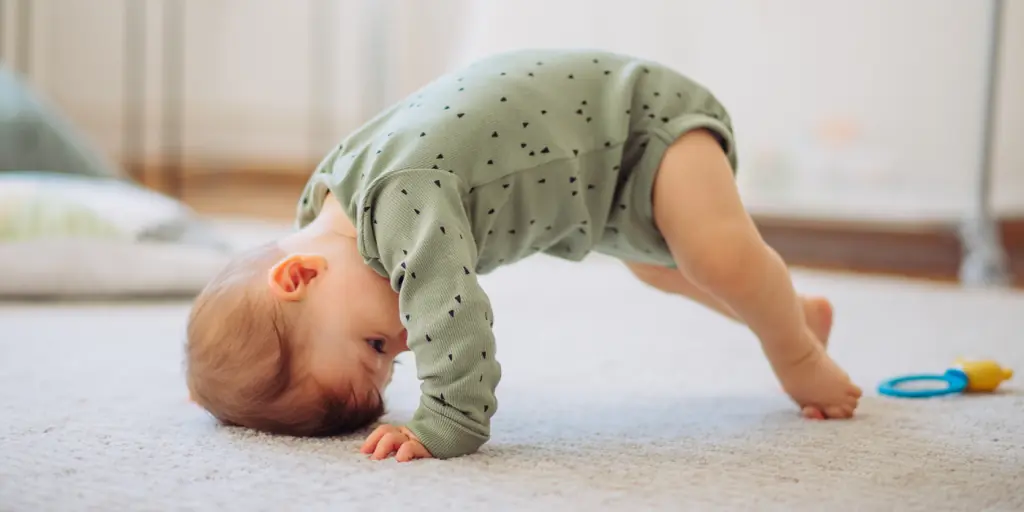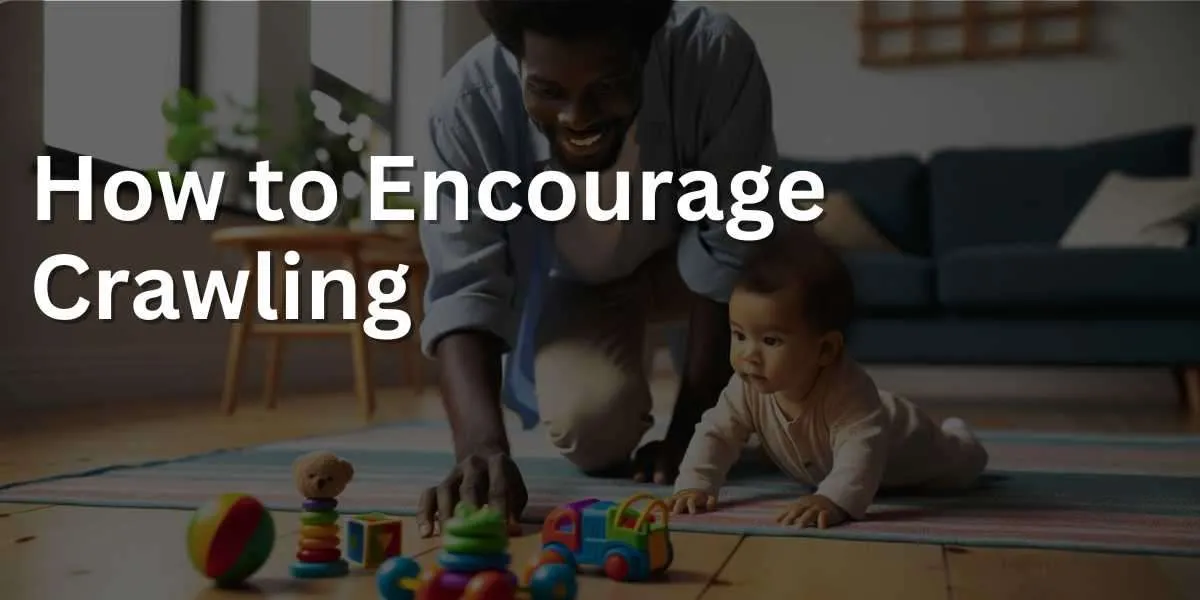How to encourage crawling sets the stage for a baby’s exciting move towards independence.
Crawling is not just a mode of transportation; it’s a critical developmental milestone that bridges the gap between stationary and upright exploration.
If you’ve watched your little one, eager for movement but unsure how to propel forward, you’re anticipating a grand adventure.
Armed with knowledge from pediatric physiotherapy and child development, I’ve crafted strategies to inspire and support those crucial first crawls.
Dive into this guide with me, and together, let’s pave the way for your baby’s delightful journey of discovery on all fours.
Crawling is an important step in your baby’s development towards walking. By building balance, improving motor skills, and promoting exploration, you can help your baby transition from crawling to walking. Remember to always provide a safe and stimulating environment for your baby to explore in.
Key Takeaways
Tummy time is an essential part of crawling and helps your baby build strength and coordination.
Each baby crawls in their own way, and some may skip crawling altogether.
Encouraging crawling can help your baby build independence and confidence.
Understanding Crawling
Crawling is a significant developmental milestone for babies. It is a crucial stage in their motor development and helps them explore their surroundings. As a parent or caregiver, understanding crawling and its stages will help you encourage your baby to crawl and make the process smoother for them.
There are different stages of crawling, and each baby progresses at their own pace. However, most babies start crawling between six to ten months. The stages of crawling include:
Pre-crawling: In this stage, your baby is learning to move their body and building strength in their arms, neck, and shoulders. They may start rolling over or pivoting on their belly.
Crawling on belly: At this stage, your baby will start moving forward on their belly using their arms and legs.
Crawling on hands and knees: In this stage, your baby will start crawling on their hands and knees, which helps them build their core strength and coordination.
Cruising: This stage is when your baby starts pulling themselves up to a standing position and using furniture to move around.
Walking: Finally, your baby will take their first steps and start walking independently.
Encouraging your baby to crawl is essential as it helps them develop their strength, coordination, and gross motor skills. Crawling also helps with their sensory development as they can touch and feel new surfaces on their hands and knees.
Watching your baby crawl for the first time is magical, and one of those first newborn milestones that marks a big step in your little one’s motor development journey.
Encouraging Baby Crawling
Encouraging your baby to crawl can be a rewarding experience, full of fun interactions and exciting developmental leaps. Here are some tips to help your little one along their crawling journey:
Tummy Time
Tummy time is important because it helps your baby develop their muscle strength, coordination, and confidence. When your baby is lying on their tummy, babies begin to use their neck, back, and shoulder muscles to lift their head, which helps to strengthen these muscles, so eventually they can lift their body weight. Its so simple, just get a great tummy time mat and then put baby tummy down, when they are older you can put them in sitting position
Having them on the floor helps develop core muscle strength as well as their back, neck, and arms. By spending time on their tummy, your baby will develop the necessary muscle strength to roll over, sit up, and then begin crawling.
Tummy time also helps your baby develop their coordination. When your baby is on their tummy, they use their arms and legs to push themselves up and move around. This movement helps your baby develop their hand-eye coordination, which is essential for crawling and other motor skills.
Enticing Toys to help encourage crawling
Toys can be a great way to encourage crawling. Choose engaging toys that will motivate your baby to move towards them. Place the toys just out of reach to encourage your baby to crawl towards them. You can also place your baby’s favorite toy a short distance away and encourage them to crawl towards it, and getting a great floor mat for crawling will also help.
Best Affordable Baby Play Mat

Give Your Baby a Safe and Fun Place to Play with the Tadpoles Baby Play Mat Puzzle!
Keep your baby safe and entertained with the Tadpoles Baby Play Mat Puzzle! This colorful and versatile play mat is perfect for tummy time, crawling, and playtime with toys
- Safe and Non-Toxic
- Large and Versatile
- Easy to Clean
- Fun and Educational
- Durable and Long-Lasting
Mirror Motivation
Babies love mirrors! Place a mirror in front of your baby during tummy time to encourage them to lift their head and strengthen their neck muscles. You can also place a mirror at the end of a tunnel to encourage your baby to crawl towards it.
Lead by Example
Get down on your hands and knees and show your baby how to crawl. They might not understand the movement right away, but demonstrating it can help.
Creating a Safe Environment
Creating a safe environment is crucial when encouraging crawling. Use baby gates to block off unsafe areas and ensure that all outlet covers are secure. Clear the area of any sharp objects or small items that your baby could choke on.
Be Patient and Supportive
Babies develop at their own pace. Encourage attempts at movement, but don’t rush the process. Always be there to cheer your little one on, celebrating every little victory along the way! Babies learn to crawl when they are ready, and remember many babies jump this step – my youngest son never went throught the crawling stage, he went straight to running at 7 months! (yes running…)
Types of Crawling
There are several types of crawling, from classic crawl, commando crawling to the backwards crawl – and many in between which you might consider abnormal crawling. Chances are it’s not, whether they are doing a bumward shuffle or a crab crawl, these are all considered crawling. Read our detailed guide to the different types of crawling and rest assured, each and everyone is fine and yes all of these crawling types are a gross motor skill!
7 Stages of Crawling
Stage 1: Prone
The first stage of crawling is called prone, which means crawling baby safe lying face down on the floor. This stage is important because it helps babies develop the strength and coordination they need to lift their head and chest off the ground.
During prone, babies also learn to push up with their arms and extend their legs behind them, which will eventually help them move forward.
Prone is usually the first position that babies learn to control, and it’s also an essential part of tummy time.
Tummy time is important because it helps babies develop the muscles they need to crawl, sit, and walk. Experts recommend starting tummy time as early as possible, even if your baby doesn’t seem to enjoy it at first.
During prone, babies may also begin to explore their environment by reaching for toys or other objects within their reach. This helps them develop hand-eye coordination and spatial awareness, which are important skills for crawling and other forms of movement.
Overall, the prone stage is an important foundation for crawling and other forms of movement. By spending time on their stomachs, babies can develop the strength, coordination, and confidence they need to start exploring their environment and moving around on their own.

Stage 2: Rolling
Rolling over is one of the first major milestones in a baby’s life, and it’s a sign that they’re well on their way to crawling. At around 4 to 6 months old, many babies will start to roll from their back to their stomach and vice versa.
This is a crucial stage in their development, as it helps them to build strength and coordination in their arms, legs, and core.
Rolling is also an important precursor to crawling, as it helps babies to learn how to shift their weight and move their body in different directions. It can be a bit scary for parents at first, but it’s important to let your baby explore and practice their rolling skills in a safe and supervised environment.
Here are some tips to help your baby develop their rolling skills:
Give them plenty of tummy time to build strength in their neck, arms, and core.
Place toys or other objects just out of reach to encourage them to reach and roll.
Use a rolled-up blanket or towel to prop them up on their side and help them practice rolling.
Be patient and give them plenty of time to practice and explore on their own.
Stage 3: Creeping
Creeping is the stage where your baby starts to move themselves around on their tummies. At this stage, your baby develops increased strength around their hips and begins moving their weight onto one side of the body, allowing the other leg to bend up.
Your baby starts crawling and will start pushing themselves forward with their arms and legs, using their toes to push off the ground. This is an important stage in your baby’s crawling development as it helps to strengthen their arms, legs, and core muscles.
During the creeping stage, your first baby crawls may shuffle forwards, backwards, or both. This movement is often referred to as the “army crawl” or “commando crawl.” It’s important to note that not all babies will go through this stage, and some may skip it altogether.
As your baby becomes more confident with their creeping, they may start to lift their tummy off the ground and crawl on all fours. This is the next stage in your baby’s crawling development, and it’s an exciting milestone to watch.
To help your baby during the creeping stage, you can encourage them to move by placing toys just out of reach to encourage crawling around. You can also place a pillow or cushion under their chest to help support them as they push themselves forward. Remember to always supervise your baby during this stage and ensure that they are safe and secure.

Stage 4: Crawling on Hands and Knees
Once your baby has mastered the army crawl, they will start to crawl on their hands and knees. This is a major milestone in their development and opens up a whole new world of exploration for them.
At this stage, your baby will start to bear weight on their hands and knees and move one arm and the opposite leg or knee forward at the same time. This classic hands-and-knees or cross crawl is the most common crawling style and is a sign that your baby is developing their gross motor skills.
As your baby practices crawling on their hands and knees, they will become more coordinated and confident. They may start to pick up speed and crawl longer distances, which can be both exciting and exhausting for parents! Do be aware of things your little one might bump in to, such as the coffee table or lamps.
Stage 5: Bear Walking
As your baby continues to develop their crawling skills, they may begin to transition from belly crawling into bear walking. This is when they bear weight on their hands and knees and then move one arm and the opposite knee forward at the same time. It’s a great sign that your baby is developing their coordination and balance.
Bear walking is an important stage in your baby’s development because it helps them build strength in their arms, legs, and core. It also helps them develop their gross motor skills, which they will need for other physical activities as they grow older.
It’s important to note that not all babies will go through this stage of crawling. Some may skip it or begin crawling altogether and move straight to standing and walking.
If your baby is bear walking, you can encourage them by giving them plenty of opportunities to practice. Set up a safe and secure space for them to crawl and explore, and provide them with toys and other objects to play with. You can also get down on the floor with them and show them how to move their arms and legs.

Stage 6: Walking with Support
Once your baby has mastered standing and cruising, they may start to take their first steps! Walking with support is the sixth stage of crawling and is an exciting milestone for both you and your little one.
At this stage, your baby will need something to hold onto for support. This could be a piece of furniture or a walker toy. They will use their hands to hold onto the support and take small steps with their feet. You may notice that their steps are wobbly and unsteady at first, but with practice, they will become more confident and stable.
It’s important to remember that every baby develops at their own pace, so don’t worry if your little one takes a bit longer to reach this stage. Some babies may skip this stage altogether and go straight to walking independently.
Here are some tips to help your baby practice walking with support:
Make sure the support is sturdy and won’t tip over easily.
Encourage your baby to take steps by holding out your hands or a toy for them to reach.
Give lots of praise and encouragement to build your baby’s confidence.
Be patient and don’t rush your baby. Let them take their time and practice at their own pace.
Stage 7: Independent Walking
At this stage, your baby is no longer crawling or cruising but is walking independently. This is a significant milestone and marks a new level of development. However, it is important to note that not all babies reach this stage at the same time.
Some may start walking as early as 9 months, while others may not start until they are 18 months or older. When your baby starts walking, you will notice that their gait may still be unsteady, and they may fall frequently.
This is normal, and you should not be alarmed. With time and practice, your baby’s walking will become more stable and confident. As your baby continues to walk, they will begin to explore their environment more independently.
They will also start to develop their balance and coordination, which will help them to run, jump, and climb. It is important to provide a safe and supportive environment for your baby to practice walking. You can do this by ensuring that your home is free of any hazards that could cause your baby to trip or fall.
You can also provide your baby with soft and comfortable shoes that will help them to grip the floor and prevent slips. In conclusion, independent walking is a significant milestone in your baby’s development. It marks a new level of independence and opens up a whole new world of exploration and discovery.
With patience, practice, and a safe environment, your baby will soon be walking confidently and exploring their world with joy and wonder.
Late to Crawl Babies
It’s perfectly natural for parents to eagerly anticipate each new milestone in their baby’s development, including crawling. However, it’s essential to remember that each baby is unique and reaches these stages at their own pace.
When it comes to crawling, there’s quite a wide range of what’s considered “normal.” While some babies are early movers and might start crawling as early as six months, others might take a bit more time, even up to a year or later. The American Academy of Pediatrics notes that many perfectly healthy babies skip crawling altogether, moving directly to standing, cruising, or walking.
So, if your baby is “late” to crawl, it doesn’t automatically mean something is wrong. In fact, there are several reasons why a baby may not be crawling yet. They might simply prefer other methods of locomotion, such as rolling or bottom shuffling. Some babies are more focused on developing other skills, like talking or fine motor skills. Others might need more practice time to build strength and coordination.
Just go through our step above and use every change you have off putting baby in the crawling position, so baby starts crawling. The more time baby spends on tummy time and building those muscles, the easier it will be for them to learn to crawl.
Commando Crawling in Babies
Commando crawling is a type of crawling that babies use to move around before they learn to crawl on all fours. It is also known as belly crawling a crab crawl, or military crawling. During this type of crawling, the baby lies on their stomach and uses their arms to pull themselves forward while their legs drag behind them.
Commando crawling is a natural developmental milestone for babies and usually occurs between the ages of six and ten months. It is an essential part of a baby’s physical development as it helps to strengthen their upper body muscles and improve their coordination and balance.
While commando crawling is a normal part of a baby’s development, some parents may become concerned if their child is not crawling in this way. It is important to remember that all babies develop at their own pace, and some may skip commando crawling altogether and move straight to crawling on all fours or even walking.
From Crawling to Walking
Encouraging your baby to crawl is an important step in their development towards walking. Once they start crawling, it’s only a matter of time before they start taking their first steps. Here are some ways you can help your baby build the necessary skills to transition from crawling to walking.
Read our detailed guide to the 7 stages of crawling, to understand your baby’s journey.
Building Balance
Walking requires good balance, and crawling is a great way to build it. Crawling helps your baby develop their core muscles, which are essential for balance. You can help your baby build balance by encouraging them to crawl on different surfaces, such as carpet, hardwood, or tile. This will help them learn how to adjust their balance to different surfaces.
Improving Motor Skills
Crawling is also an excellent way to improve your baby’s motor skills. Crawling requires coordination between the hands and knees, which helps develop both fine and gross motor skills. You can help your baby improve their motor skills by placing toys just out of reach, which will encourage them to crawl towards them. This will help them develop their hand-eye coordination and improve their motor skills.
Promoting Exploration
Crawling is a great way for your baby to explore their environment. It allows them to move around and discover new things. You can help promote exploration by creating a safe and stimulating environment for your baby to crawl in.
Make sure to baby-proof your home and remove any potential hazards. You can also provide your baby with toys and objects to crawl towards, which will encourage them to explore their environment.
FAQS on How to Promote Crawling
How can I encourage my baby to crawl?
To encourage your baby to crawl, provide ample tummy time to build upper body strength. Place toys or interesting objects slightly out of reach to motivate them to move towards them. Be around them, ensuring a safe space for their attempts. Praise every effort to instill confidence and a sense of achievement.
Should you encourage babies to crawl?
Yes, encouraging babies to crawl is beneficial as it contributes to their physical and cognitive development. Crawling enhances their strength, balance, coordination, and spatial awareness. It also builds a foundation for further motor skills like standing and walking.
What age is too late for crawling?
While the average age for crawling is between 6-10 months, there’s a wide range of normal. Some babies may not crawl until 12 months or may skip crawling altogether. However, if your baby shows no signs of movement like rolling or scooting by their first birthday, consult with a pediatrician or child development specialist.
What causes babies not to crawl?
Various factors can cause babies not to crawl. Some might prefer other forms of mobility like rolling or bottom shuffling. Others might be more focused on developing different skills, such as verbal communication or fine motor skills. In rare cases, delays in crawling could signal a developmental issue.
What is the average age of crawling?
The average age for babies to start crawling is between 6 and 10 months. However, some babies may start as early as 4 months or as late as a year or more, and that’s still within the range of normal development.
Should I be worried if my 9 month old isn’t crawling?
Not necessarily. While some babies start crawling around 6 to 10 months, others may take longer. Remember, every baby is unique and develops at their own pace. If your 9-month-old isn’t showing any interest in moving, rolling, or shifting positions, it might be a good idea to discuss this with your pediatrician.
How do you promote crawling in occupational therapy?
Occupational therapists promote crawling by using various strategies tailored to each child’s needs. They may use play-based activities to strengthen the baby’s muscles, improve their balance, and boost their coordination. Therapists may also use toys and items to motivate the baby to move, helping them practice weight shifting, a key skill for crawling.




